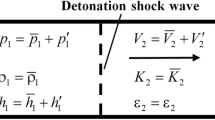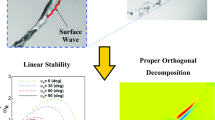Abstract.
The interaction of two oblique axisymmetrical shock waves in a uniform supersonic flow has been investigated both theoretically and experimentally. The first shock is produced by a conical ring with a sharp leading edge located at the exit of a supersonic nozzle. The second shock is generated by a centre-body placed in the test chamber and along the symmetry axis of the nozzle. This flow field is absolutely free of three-dimensional edge effects. The displacement of this mobile centre-body leads to an interaction of an oblique shock wave with a diverging shock where both shock strengths are changing. Experimental results have shown three different structures of the two shock wave interaction and hysteresis effects between them. A description of these shock wave interactions is obtained by numerically solving the Euler and Navier-Stokes equations. Comparison with experiment shows the importance of viscous effects through shock/boundary-layer interaction for a correct description and understanding of these complex flows.
Similar content being viewed by others
Author information
Authors and Affiliations
Corresponding author
Additional information
Received: 13 February 2002, Accepted: 19 August 2002, Published online: 28 April 2003
Rights and permissions
About this article
Cite this article
Burtschell, Y., Zeitoun, D.E. Shock/shock and shock/boundary layer interactions in an axisymmetric steady laminar flow. Shock Waves 12, 487–495 (2003). https://doi.org/10.1007/s00193-003-0187-0
Issue Date:
DOI: https://doi.org/10.1007/s00193-003-0187-0




